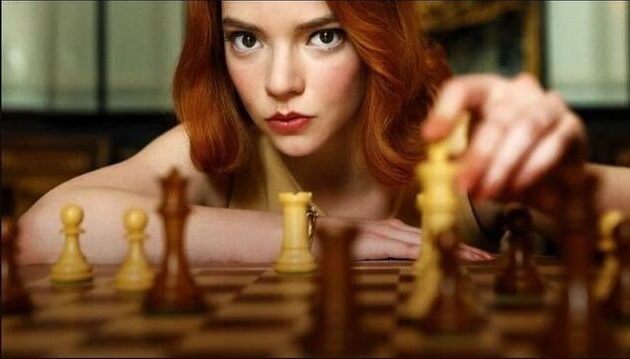How can a game of chess be engaging? I mean, the chess world is surely fascinating, but not really easy to get into. Even though I don’t play soccer or pole vaulting, I can still follow a game or a race on TV and have fun watching it, but chess is different: I know the rules, and I used to play it (actually I used to lose), but still I don’t find it fun to watch a chess game. I don’t even understand what’s happening.
Well, I must admit I enjoyed every chess game in “The Queen’s Gambit”, a miniseries released by Netflix in October 2020. I love everything about that series. And it seems I’m not the only one.
The plot is nothing too complicated: Elizabeth Harmon (Beth) is a 9 years old girl, without a father, when her mother died. She is taken into an orphanage, where she learns how to play chess and once she gets out, Beth starts building her way into the chess world.
It’s basically the story of a self-made man. Actually a self-made woman. A person who starts from the bottom and thanks to her great qualities and efforts is able to become someone.
Well then, chess is not engaging and the plot is nothing special, so what’s so interesting about that series? What keeps your eyes stuck on the screen?
First of all, it’s a short series. When searching for something to watch, the length is the second thing we notice after the cover, and if we’re looking for something easy, this series surely is tempting. It consists of 7 episodes, of about 50 minutes each. This means it’s not too demanding, if you have time to waste, or you are on vacation you’re done with the series in a couple of days.
Another point is the narration which starts “in medias res”. The first sequence is very dynamic: Elizabeth gets up all wet in a bathtub in her hotel room; she opens the curtains, letting the sun pass through the windows, while she’s told that she’s late. She rapidly swallows two green pills and then she starts running barefoot through the corridors, into the elevator, next to the bar counter, across the dining room until she arrives at a closed door. While she opens the door, a crowd of journalists and photographers start taking pictures with excitement. Only then we realize she’s late for her chess game against a cold, impassive, mysterious person.
We just see this scene, and suddenly we are thrown into a completely different world: two police officers talking about a car accident involving a little girl.
So what was that initial scene we saw? How does she end up there? If we want to know more about it, we’ll have to keep watching and wait until the sixth episode.
Through this first short sequence we sympathize with the protagonist right away. Yes, because it’s clear from the beginning that Elizabeth has some problems; her hotel room is full of alcohol and she’s taking some kind of pills, making sure that nobody’s watching, with a strange look in her eyes. But she doesn’t only have problems, she’s unlucky too: we can immediately recognise her as a child, standing in front of the car accident in which her mother died; the images and the conversations between the two cops make it clear.
It’s easy for the spectator to empathize with her pain; people are usually more touched by a sad scene than a happy one.
One last reason I can think of is that the communication is very visual. We don’t have a lot of conversations, most of the time the characters communicate with their eyes, facial expressions, and only a few words. This keeps the spectator’s eyes on the TV, because if he gets distracted, he might lose part of the communication.
Last but not least: the setting. I found it amazing. Roads, buildings, houses, clothes, colors, cars… They take you back to the 60’s, and they capture your attention. Moreover, the context (buildings, clothing…) changes according to the peculiarities of the place: a little city in Kentucky with plain buildings, the elegance of Paris, and the cold wintry Moscow.
So, length, narration in medias res, empathy, communication, setting; those are the elements that lure us into this TV series, but what keeps us watching?
I think that this is very personal.
What kept me watching was realizing that the series is not really about chess. Don’t get me wrong, of course the chess-board plays a fundamental role, but it’s not the only protagonist. We never see an entire chess game, but we usually hear Beth’s narration of the game, her emotions while replaying it in her mind.
What I see is a woman breaking into a world ruled by men, I see serious problems of addiction (Beth goes with drugs and alcohol her whole life), I see how racism and homophobia are deeply rooted in the American society (especially in the 60’).
The thing I found most fascinating is probably not the most important: I liked the time, the context. We are living in the clou of the Cold War, Americans fighting against Russians, but not with soldiers on the battle ground, instead in races and competitions. Individualism against collectivity. Capitalism against communism.
Well, the story is written by an American in 1983, so of course communism didn’t win, and the USA was on top of the world.
I’d like to conclude with my favourite conversation:
Benny: The soviets. You know why they’re the best players in the world?
Elizabeth: They have the best suites?
Benny: It’s because they play together as a team, especially during adjournments, they help each other out. Us Americans, we work alone because we’re all such individualists, we don’t like anyone helping us.
Cristian Polci 5AS
